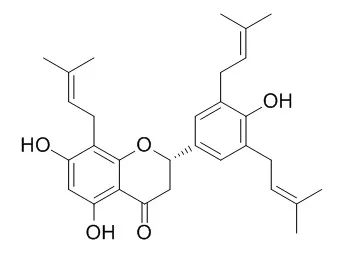| In vitro: |
| Arch Pharm Res. 2007 Nov;30(11):1398-403. | | Biological activities of the chemical constituents of Erythrina stricta and Erythrina subumbrans.[Pubmed: 18087807] |
METHODS AND RESULTS:
Phytochemical investigation of the hexane and CH2Cl2 extracts of Erythrina stricta roots and E. subumbrans stems led to the isolation of six pterocarpans, one flavanone, one isoflavone, two alkaloids, five triterpenes, six steroids and alkyl trans-ferulates.
The structures of all known compounds were determined on the basis of spectroscopic evidence. Sophoradiol (15), a mixture of stigmast-4-en-3-one (19) and stigmasta-4,22-dien-3-one (20), lupeol (21), cycloeucalenol (22), a mixture of 3beta-hydroxystigmast-5-en-7-one (23) and 3beta-hydroxystigmast-5,22-dien-7-one (24) and melilotigenin C (25) were first isolated from the genus Erythrina. The isolated compounds were evaluated for antiplasmodial activity, antimycobacterial activity and cytotoxicity.
CONCLUSIONS:
Among the tested compounds, 5-Hydroxysophoranone (8) exhibited the highest antiplasmodial activity against Plasmodium falciparum (IC50 2.5 microg/mL). Compound 8, erystagallin A (5), erycristagallin (7) and erysubin F (10) showed the same level of antimycobacterial activity against Mycobacterium tuberculosis (MIC 12.5 microg/mL). For cytotoxicity, erybraedin A (2) showed the highest activity against the NCI-H187 and BC cells (IC50 2.1 and 2.9 microg/mL, respectively), whereas 10 exhibited the highest activity against the KB cells (IC50 4.5 microg/mL). | | J Ethnopharmacol. 2007 Mar 1;110(1):171-5. | | Antibacterial pterocarpans from Erythrina subumbrans.[Pubmed: 17055201 ] |
METHODS AND RESULTS:
Seven pterocarpans, erybraedin B (1), erybraedin A (2), phaseollin (3), erythrabyssin II (4), erystagallin A (5), erythrabissin-1 (6) and erycristagallin (7), two flavanones, 5-Hydroxysophoranone (8) and glabrol (9), and one isoflavone, erysubin F (10), were isolated from the stems of Erythrina subumbrans (Leguminosae). Their structures were identified by means of spectroscopy. This is the first report of the isolation of the non-alkaloidal compounds from Erythrina subumbrans and the observed dehydration of 6a-hydroxypterocarpans 5 and 6 in CDCl(3) to the corresponding pterocarpenes 11 and 12, respectively. Compounds 8 and 9 were isolated for the first time from the genus Erythrina. Compounds 2 and 4 exhibited the highest degree of activity against Streptococcus strains with an MIC range of 0.78-1.56 microg/ml, whereas compound 7 exhibited the highest degree of activity against Staphylococcus strains, including drug-resistant strains (MRSA and VRSA), with an MIC range of 0.39-1.56 microg/ml. Interestingly, compounds 2, 4, 5 and 7 were more active against several strains of Streptococcus and Staphylococcus than the standard antibiotics vancomycin and oxacillin. Compound 7 showed the highest level of activity against all VRSA strains tested, with an MIC range of 0.39-1.56 microg/ml, which were resistant to both antibiotics.
CONCLUSIONS:
These compounds may prove to be potent phytochemical agents for antibacterial activity, especially against the MRSA and VRSA strains. |
|






 Cell. 2018 Jan 11;172(1-2):249-261.e12. doi: 10.1016/j.cell.2017.12.019.IF=36.216(2019)
Cell. 2018 Jan 11;172(1-2):249-261.e12. doi: 10.1016/j.cell.2017.12.019.IF=36.216(2019) Cell Metab. 2020 Mar 3;31(3):534-548.e5. doi: 10.1016/j.cmet.2020.01.002.IF=22.415(2019)
Cell Metab. 2020 Mar 3;31(3):534-548.e5. doi: 10.1016/j.cmet.2020.01.002.IF=22.415(2019) Mol Cell. 2017 Nov 16;68(4):673-685.e6. doi: 10.1016/j.molcel.2017.10.022.IF=14.548(2019)
Mol Cell. 2017 Nov 16;68(4):673-685.e6. doi: 10.1016/j.molcel.2017.10.022.IF=14.548(2019)